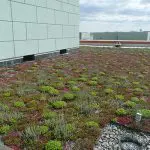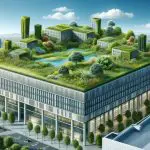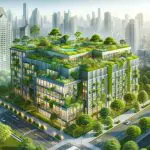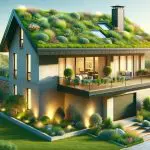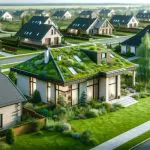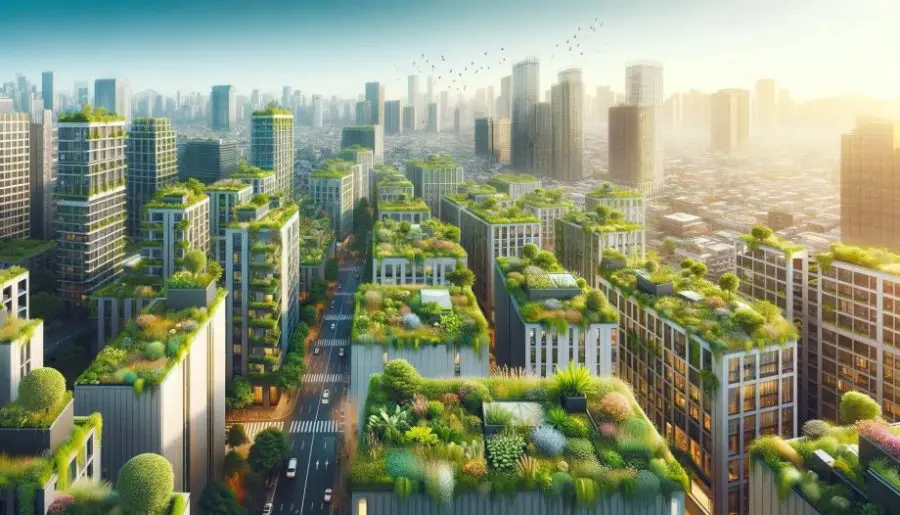
Exploring the importance of urban sustainability? Discover why we need green roofs and their impact on our cities. Learn more in our insightful guide!
Key Takeaways:
- Why Do We Need Green Roofs?
- Green roofs are essential for sustainable urban living.
- They help reduce heat in cities, lower energy costs, improve air quality, and provide habitats for wildlife.
- These living roofs also manage stormwater effectively, reducing the burden on city drainage systems.
- Green roofs bring nature back into urban areas, contributing significantly to environmental and social well-being.
Ever wondered why we need green roofs? These innovative solutions are more than just an aesthetic addition to cityscapes.
Green roofs play a pivotal role in enhancing urban environments. They offer benefits like improved air quality, energy efficiency, and biodiversity.
In this discussion, we’ll delve into the world of green roofs, uncovering their significance in our quest for sustainable living.
Why Do We Need Green Roofs?
In the heart of bustling cities, green roofs are emerging as key players in urban sustainability.
These living roofs, blanketed with vegetation, offer more than just a dash of green in a concrete landscape. They’re increasingly recognized as vital tools in addressing environmental challenges.
Green roofs are not just trendy architectural features; they play a crucial role in urban planning.
By bringing nature to our doorsteps, they combat pressing issues like air pollution, urban heat islands, and stormwater management.
This introduction explores why green roofs are more than just a pretty sight—they’re essential in our journey towards sustainable urban living.
- Understanding Green Roofs:
- Definition and basic structure.
- Varieties of green roofs and their specific features.
- The Urban Jungle and Green Relief:
- The contrast between traditional urban landscapes and green roofs.
- How green roofs integrate with and improve urban environments.
- Addressing Environmental Challenges with Green Roofs:
- The role of green roofs in mitigating urban heat islands.
- How they contribute to improved air quality and reduction in air pollution.
- Water Management and Green Roofs:
- The importance of green roofs in managing stormwater in cities.
- Benefits in reducing runoff and water pollution.
- Biodiversity Boost in Urban Areas:
- How green roofs contribute to increasing urban biodiversity.
- The importance of green spaces for urban wildlife.
- Green Roofs and Urban Sustainability:
- The role of green roofs in sustainable urban development.
- Long-term environmental benefits and contributions to eco-friendly cities.
How Do Green Roofs Work?
Understanding the mechanics of green roofs is key to appreciating their value in urban environments.
This section delves into their structure and functionality, focusing on how they manage water, regulate temperature, and support diverse plant life.
- The Multi-Layered Design of Green Roofs:
- Waterproof and Root Barrier Layers: Essential for protecting the building from water and root penetration.
- Drainage and Filtration Systems: Critical for managing excess water and preventing waterlogging.
- Growing Medium: Typically a lightweight substrate, it supports plant growth without overburdening the roof structure.
- Vegetation Layer: Usually drought-resistant species like sedums or native plants adapted to local climates.
- Mastering Water Management:
- Rainwater Retention: Green roofs can retain 50-90% of the rainfall they receive, significantly reducing runoff.
- Natural Water Filtration: They filter and purify rainwater, enhancing water quality before it enters drainage systems.
- Regulating Urban Temperatures:
- Natural Insulation: Green roofs provide insulation, reducing the need for heating in winter and air conditioning in summer.
- Combatting Heat Islands: They help lower urban temperatures by absorbing sunlight and cooling the air through evapotranspiration.
- Fostering Urban Biodiversity:
- Diverse Plant Life: Supports a range of plants, from simple mosses to complex gardens, depending on the roof type.
- Habitats for Wildlife: They create mini-ecosystems, attracting birds, bees, and other urban wildlife.
- Sustainable Urban Development:
- Long-Term Benefits: Beyond immediate environmental impacts, green roofs contribute to building longevity and energy savings.
- Economic Advantages: They can double or even triple a roof’s lifespan and reduce energy costs.
- Challenges and Considerations:
- Structural Requirements: Understanding the weight and maintenance needs is crucial for successful implementation.
- Cost-Benefit Analysis: Weighing initial costs against long-term environmental and financial benefits.
How Do Green Roofs Help the Environment?
Green roofs are more than just an aesthetic addition to urban landscapes; they are a powerhouse in tackling environmental issues.
This section highlights the significant environmental benefits green roofs offer, such as air purification, CO2 reduction, and stormwater management, and their role in mitigating urban heat islands and enhancing biodiversity.
- Air Purification and CO2 Reduction:
- Natural Air Filters: Green roofs absorb pollutants and filter particulate matter, improving air quality.
- CO2 Absorption: Plants on green roofs convert CO2 into oxygen, reducing greenhouse gas levels and combating climate change.
- Stormwater Management:
- Rainwater Absorption: These roofs can retain a substantial portion of rainfall, easing the load on urban drainage systems.
- Water Quality Improvement: By filtering rainwater, green roofs help reduce the pollution entering waterways.
- Mitigating Urban Heat Island Effect:
- Temperature Regulation: Green roofs absorb and reflect sunlight, reducing the heat absorbed by buildings and surrounding areas.
- Cooling Urban Areas: They can significantly lower the temperature in cities, making them more livable and reducing energy demand for cooling.
- Promoting Urban Biodiversity:
- Habitats for Wildlife: By providing green spaces, these roofs attract birds, bees, and other species, enhancing urban biodiversity.
- Connecting Green Spaces: Green roofs can act as stepping stones, linking isolated green areas and supporting wider ecological networks.
- Contributing to Sustainability:
- Reducing Energy Consumption: By offering insulation, green roofs decrease the energy needed for heating and cooling buildings.
- Long-term Environmental Impact: Their role in sustainable urban planning goes beyond immediate effects, contributing to a greener future.
- Enhancing Water Cycle and Ecosystem Services:
- Evapotranspiration: Green roofs play a role in the natural water cycle, returning water to the atmosphere.
- Ecosystem Services: They provide crucial ecological functions such as carbon sequestration and temperature regulation.
Types of Green Roofs
Green roofs come in various types, each with its unique characteristics and benefits.
This section introduces the three main categories – extensive, intensive, and semi-intensive – and also discusses the emerging trend of biosolar green roofs.
- Extensive Green Roofs:
- Characteristics: Lightweight, low-maintenance, and often don’t require irrigation.
- Vegetation: Typically covered with hardy, drought-resistant plants like sedums.
- Suitability: Ideal for large areas where regular access isn’t necessary.
- Benefits: Cost-effective and excellent for environmental benefits like stormwater management and habitat creation.
- Intensive Green Roofs:
- Characteristics: Heavier and more complex, resembling traditional gardens.
- Vegetation: Can support a wide range of plants, including shrubs and small trees.
- Requirements: Needs more maintenance, irrigation, and strong structural support.
- Uses: Often designed for recreational use with walkways and seating areas.
- Semi-Intensive Green Roofs:
- Blend of Extensive and Intensive: Combines elements of both, with moderate weight and maintenance needs.
- Vegetation Variety: Supports a diverse range of plants, more than extensive but less than intensive roofs.
- Flexibility in Design and Use: Suitable for a variety of buildings and purposes.
- Biosolar Green Roofs:
- Innovative Integration: Combines green roofing with solar panel technology.
- Energy and Environmental Benefits: Enhances the efficiency of solar panels while retaining the ecological benefits of green roofs.
- Sustainable Urban Development: Represents a cutting-edge approach to sustainable building design.
- Choosing the Right Type:
- Factors to Consider: Building structure, maintenance capacity, budget, and desired environmental benefits.
- Customization: Flexibility to tailor green roof designs based on specific needs and goals.
Green Roof Sustainability
Green roofs are a cornerstone in the pursuit of sustainable urban development.
This section delves into how they contribute to this goal, focusing on their impact on reducing energy consumption and fostering ecological balance.
- A Pillar of Sustainable Urban Planning:
- Urban Heat Island Mitigation: They help cool cities, reducing the need for air conditioning and associated energy use.
- Stormwater Management: Green roofs manage rainwater sustainably, easing the burden on urban drainage systems.
- Energy Efficiency and Reduction:
- Insulating Properties: Act as natural insulators, decreasing the need for heating and cooling in buildings.
- Long-Term Energy Savings: This can significantly reduce a building’s overall energy consumption, contributing to a lower carbon footprint.
- Enhancing Ecological Balance:
- Biodiversity Support: Create habitats for a variety of urban wildlife, contributing to ecological diversity.
- Air Quality Improvement: By filtering pollutants and producing oxygen, they improve the urban air quality.
- Green Roofs and Water Conservation:
- Rainwater Harvesting: They can be designed to collect rainwater for reuse, promoting water conservation.
- Reducing Runoff and Pollution: Limit the amount of stormwater runoff and its consequent pollution.
- Carbon Sequestration:
- Combatting Climate Change: The vegetation on green roofs captures and stores carbon dioxide, helping mitigate climate change effects.
- Economic Sustainability:
- Cost-Benefit Analysis: While initial installation costs are higher, the long-term savings in energy and roof maintenance are significant.
- Increasing Property Value: Green roofs can enhance the aesthetic and ecological value of a building, making it more attractive to tenants and buyers.
- Promoting Healthier Urban Environments:
- Social and Psychological Benefits: Apart from environmental benefits, green roofs contribute to the well-being of urban residents by providing green spaces for relaxation and recreation.
What Are the Benefits of Green Roofs?
Green roofs offer a myriad of benefits, ranging from extending the life of roofing materials to improving the well-being of city dwellers.
This section outlines these advantages, emphasizing both their practical and societal impacts.
- Extended Roof Lifespan:
- Protection Against Elements: Shields the roof from UV rays, extreme temperatures, and physical damage.
- Increased Durability: Can double or even triple a roof’s life expectancy by reducing wear and tear.
- Thermal Insulation:
- Energy Efficiency: Acts as a natural insulator, reducing heating costs in winter and cooling costs in summer.
- Climate Control: Helps maintain a stable temperature inside buildings, enhancing comfort levels.
- Wildlife Habitat Support:
- Urban Biodiversity: Offers habitats for birds, bees, and other beneficial insects, enriching urban biodiversity.
- Ecological Networks: Acts as stepping stones that link isolated green spaces, supporting broader ecological networks.
- Societal and Psychological Benefits:
- Improved Well-being: Green spaces are known to reduce stress and promote mental health.
- Enhanced Social Cohesion: Encourages community interaction and engagement, fostering a sense of belonging.
- Educational Opportunities: Can be used as living laboratories for educational purposes.
- Stormwater Management:
- Reduces Runoff: Absorbs and filters rainwater, decreasing the risk of flooding and sewer overflow.
- Water Quality Enhancement: Natural filtration improves the quality of water entering the drainage systems.
- Air Quality Improvement:
- Pollutant Filtration: Plants capture airborne pollutants, contributing to cleaner urban air.
- Oxygen Production: Vegetation converts CO2 into oxygen, enhancing overall air quality.
- Urban Heat Island Mitigation:
- Cooling Effect: Reduces the ambient temperature in cities, mitigating the urban heat island effect.
- Energy Savings: Lessens the demand for air conditioning, leading to lower energy consumption.
- Aesthetic and Economic Value:
- Visual Appeal: Enhances the aesthetic appeal of buildings.
- Property Value: Can increase the market value of properties and attract environmentally conscious tenants or buyers.
- Promoting Healthier Urban Environments:
- Recreational Spaces: Provides green areas for relaxation and enjoyment in densely populated urban areas.
- Healing Environments: Studies show that views of greenery can aid in faster recovery for patients and reduce pain tolerance.
These benefits demonstrate the multifaceted value of green roofs, from tangible environmental impacts to intangible societal gains.
Disadvantages of Green Roofs
While green roofs offer numerous benefits, they also come with certain challenges and drawbacks.
It’s important to consider these factors to make an informed decision about implementing green roofs.
This section explores the main disadvantages.
- Higher Initial Costs:
- Installation Expense: Green roofs require a higher upfront investment compared to traditional roofing due to the materials and specialized labor involved.
- Structural Adjustments: Some buildings may need additional structural support to bear the weight of a green roof, increasing costs.
- Maintenance Requirements:
- Regular Upkeep: Unlike conventional roofs, green roofs require ongoing maintenance, including watering, weeding, and repairs.
- Professional Services: Maintenance might require the expertise of horticultural professionals, adding to the long-term costs.
- Complex Installation Process:
- Technical Expertise: Installing a green roof involves multiple layers and systems, demanding skilled labor and careful planning.
- Time-Consuming: The installation process can be more time-intensive than that of traditional roofs.
- Weight Concerns:
- Structural Load: Green roofs are heavier, especially when wet, and might not be suitable for all building types without significant reinforcement.
- Engineering Assessments: Buildings often require a thorough structural evaluation before installation, which can be costly and time-consuming.
- Waterproofing and Drainage Issues:
- Risk of Leaks: If not installed correctly, green roofs can pose a risk of water leaks, potentially damaging the underlying structure.
- Drainage Challenges: Proper drainage is crucial to prevent waterlogging, which requires careful design and installation.
- Plant Survival and Biodiversity:
- Climate Suitability: Plant choices are limited by local climate conditions, and not all species may thrive on a rooftop environment.
- Biodiversity Limitations: While green roofs can enhance biodiversity, they cannot replicate the full range of habitats found on the ground.
- Long-Term Viability and Replacement:
- Life Span of Materials: Some components of green roofs, like the waterproof membrane, may need replacement over time.
- Renovation and Repair Costs: Future renovations or repairs can be more complex and costly compared to traditional roofs.
- Limited Access and Use:
- Accessibility: Some green roofs, particularly extensive types, are not designed for frequent human access.
- Recreational Limitations: Not all green roofs can be used as public or recreational spaces due to their design and load-bearing capacity.
Understanding these challenges is crucial for anyone considering the installation of a green roof.
Each factor should be weighed against the potential benefits to determine if a green roof is the right choice for a particular building or project.
Green Roof Cost
Understanding the financial aspect of green roofs is crucial for anyone considering their installation. This section provides an overview of the costs involved, along with the long-term savings and potential financial incentives.
- Initial Installation Costs:
- Material and Labor Expenses: The cost varies depending on the type of green roof (extensive, intensive, or semi-intensive) and the complexity of the design.
- Structural Modifications: Additional expenses may arise if the building requires structural reinforcement to support the green roof.
- Maintenance Costs:
- Regular Upkeep: Ongoing expenses include irrigation, weeding, fertilizing, and occasional repairs.
- Professional Services: Depending on the complexity, maintenance may require hiring professionals, adding to the cost.
- Long-Term Savings:
- Energy Efficiency: Green roofs contribute to significant energy savings by providing natural insulation.
- Roof Longevity: Protecting the underlying structure from weather and UV damage, green roofs can extend the life of a roof, reducing the need for costly replacements.
- Financial Incentives and Rebates:
- Government Subsidies: Some regions offer incentives, rebates, or tax credits for installing green roofs, which can offset initial costs.
- Reduced Stormwater Fees: In certain areas, green roofs can lead to reduced stormwater utility fees due to their water retention capabilities.
- Cost Comparison with Traditional Roofs:
- Initial vs. Long-Term Costs: While more expensive upfront, the long-term financial benefits of green roofs can surpass those of traditional roofing options.
- Case Studies and Examples: Referencing specific examples where green roofs have proven to be cost-effective over time.
- Return on Investment (ROI):
- Property Value Increase: Green roofs can enhance property values and attract environmentally-conscious tenants or buyers.
- Energy and Maintenance Savings: Calculating the ROI by factoring in energy savings and reduced maintenance costs over time.
- Budgeting for Green Roofs:
- Planning and Design Costs: Including the costs of planning and designing a green roof in the overall budget.
- Customized Solutions: Tailoring green roof designs to fit specific budget constraints and building requirements.
This section is designed to give a comprehensive view of the costs associated with green roofs, balancing initial investments against long-term financial benefits.
Costs
When it comes to the cost of green roofs, both extensive and intensive types have different price points due to their structural and maintenance requirements.
For extensive green roofs, which are more basic and have a shallow growing area, the cost starts at around $10 per square foot. These roofs typically feature vegetation like mosses, sedums, and grass and are lower in maintenance and cost due to the lack of a need for complex drainage or irrigation systems.
Intensive green roofs, on the other hand, are more advanced and resemble traditional gardens with deep soil, irrigation systems, and drainage. Because of these additional features, the cost for intensive green roofs is higher, starting at $25 per square foot. This type of green roof is ideal for growing a variety of plants and can be used to create recreational spaces on top of buildings.
Annual maintenance costs for either type of green roof may range from $0.75 to $1.50 per square foot. It’s important to note that these figures can vary based on specific project requirements, the building’s location, and the chosen vegetation.
These costs reflect the initial installation and do not account for the long-term savings that green roofs can provide through energy efficiency, extended roof lifespan, and stormwater management benefits. While the upfront costs are higher than traditional roofing materials, green roofs can offer substantial long-term financial and environmental benefits.
Green Roof Cost Table
Here is a table displaying the cost and characteristics of extensive and intensive green roofs:
| Type of Green Roof | Initial Cost per Square Foot | Annual Maintenance Cost per Square Foot | Characteristics |
|---|---|---|---|
| Extensive Green Roofs | $10 | $0.75–$1.50 | Shallow growing area, less maintenance, suited for mosses, sedums, grass. |
| Intensive Green Roofs | $25 | $0.75–$1.50 | Deep soil, more complex, suitable for a wide variety of plants and recreational use. |
This table offers a clear comparison of the two types of green roofs in terms of costs and features.
FAQs
This section answers common questions about green roofs, focusing on their importance, economic impact, benefits related to water management, and overall advantages and disadvantages.
Q: Why is a green roof important?
A: Green roofs are important for several reasons. They help reduce the urban heat island effect, improve air quality, manage stormwater, and increase biodiversity in urban areas.
Additionally, they provide insulation, reduce energy costs for heating and cooling, and extend the lifespan of the roof.
Q: How will a green roof affect the economy?
A: Green roofs positively impact the economy by reducing energy costs, creating jobs in green roof installation and maintenance, and increasing property values.
They also have the potential to reduce municipal infrastructure costs related to stormwater management.
Q: Why are green roofs good for water?
A: Green roofs are beneficial for water management as they absorb and retain rainwater, which reduces runoff and the risk of flooding.
This natural filtration process also improves water quality by filtering pollutants before the water reaches the drainage systems.
Q: Is a green roof good or bad?
A: Generally, green roofs are considered good due to their numerous environmental benefits, such as improving air quality, reducing urban heat, and supporting biodiversity.
However, they do come with challenges like higher initial costs and maintenance requirements, which should be considered.
Q: What are 5 benefits of a green roof?
- Environmental Protection: Reduces urban heat island effect and improves air quality.
- Energy Efficiency: Provides natural insulation, reducing heating and cooling costs.
- Water Management: Absorbs rainwater, reducing runoff and improving water quality.
- Biodiversity: Creates habitats for various urban wildlife species.
- Aesthetic and Economic Value: Enhances building aesthetics and potentially increases property value.
Q: How long does a green roof last?
A: With proper maintenance, green roofs can last up to 40-50 years, significantly longer than conventional roofs.
Q: Can green roofs support solar panels?
A: Yes, green roofs can support solar panels. Combining green roofs with solar panels can enhance the efficiency of the panels by lowering roof temperatures.
Q: Are green roofs suitable for all types of buildings?
A: While green roofs can be adapted to many building types, structural considerations such as weight capacity are crucial.
Buildings may require structural reinforcement to support the additional weight of a green roof.
Q: What types of plants are used on green roofs?
A: Plants for green roofs are typically drought-resistant and hardy, such as sedums, grasses, and native wildflowers.
The choice depends on the roof type and local climate.
Q: How much maintenance does a green roof require?
A: Maintenance levels vary by type. Extensive green roofs require minimal maintenance, primarily seasonal weeding and inspection.
Intensive green roofs, resembling traditional gardens, need regular watering, weeding, and other garden maintenance activities.
Conclusion: Embracing Green Roofs for a Sustainable Future
In this exploration of green roofs, we’ve uncovered their multifaceted benefits and their essential role in shaping sustainable urban environments.
Green roofs stand out as innovative solutions, addressing environmental challenges while offering economic and social advantages.
So what is a green roof? As we conclude, let’s recap the key points and emphasize the significance of green roofs in our journey towards greener cities.
- A Vital Tool for Urban Sustainability:
- Environmental Impact: Green roofs are powerful in mitigating urban heat islands, improving air quality, and managing stormwater.
- Economic Advantages: They contribute to energy savings and can enhance property values.
- Challenges and Solutions:
- Balancing Costs and Benefits: While the initial costs and maintenance requirements are higher, the long-term benefits justify the investment.
- Adaptability and Versatility: Green roofs can be customized to suit various building types and purposes.
- The Future of Urban Landscapes:
- Growing Trend: The increasing adoption of green roofs in cities worldwide reflects a shift towards more sustainable and livable urban spaces.
- Policy and Community Engagement: Encouragement from local governments and community involvement are key to the widespread implementation of green roofs.
- A Call to Action:
- Encouraging Wider Adoption: Understanding and promoting the benefits of green roofs can lead to more widespread acceptance and implementation.
- Integration in Urban Planning: Green roofs should be a fundamental part of urban planning, contributing to the health and well-being of urban residents.
- Conclusion:
- Green roofs are not just a trend but a necessity in the face of urbanization and climate change. Their ability to provide environmental, economic, and social benefits simultaneously makes them an invaluable component of modern urban development. As cities continue to evolve, the integration of green roofs will play a pivotal role in ensuring sustainable, resilient, and healthy urban environments.
This summary highlights the importance of green roofs and calls for their increased integration into urban planning for a sustainable future.
Resources Section
For those interested in delving deeper into the world of green roofs, the following resources offer valuable information.
These links provide a mix of academic research, practical guides, and policy insights, catering to a wide range of interests from environmental enthusiasts to urban planners.
Green Roofs for Healthy Cities:
Website: greenroofs.org
Description: A non-profit organization dedicated to promoting green roofs across North America. Provides resources, research, and case studies.
The International Green Roof Association (IGRA):
Website: internationalgreenroof.org
Description: Offers extensive information on green roof benefits, guidelines, and global green roof projects.
Green Roof Systems: A Guide to the Planning, Design and Construction of Building Over Structure by Susan Weiler and Katrin Scholz-Barth:
Link: Available on Amazon
Description: A comprehensive book covering the technical aspects of green roofing.
Planting Green Roofs and Living Walls by Nigel Dunnett and Noël Kingsbury:
Link: Available on Amazon
Description: Provides practical advice on planting and maintaining green roofs and living walls.
EPA’s Green Roofs Page:
Website: epa.gov
Description: The U.S. Environmental Protection Agency’s page on green roofs, offering insights into their environmental benefits.
The Green Roof Manual: A Professional Guide to Design, Installation, and Maintenance by Edmund C. Snodgrass and Linda McIntyre:
Link: Available on Amazon
Description: A guidebook that covers all aspects of green roof design, installation, and maintenance.
Journal of Living Architecture:
Website: livingarchitecturemonitor.com
Description: A journal offering the latest research and trends in green roof and wall design, policy, and technology.
Green Roof Research Program at Michigan State University:
Website: greenroofs.com
Description: Features research findings and resources from one of the leading academic programs on green roofs.
Building Green: A Complete How-To Guide to Alternative Building Methods by Clarke Snell and Tim Callahan:
Link: Available on Amazon
Description: While covering various green building techniques, this book includes a section on green roofs.
These resources will provide a comprehensive understanding of green roofs, their benefits, challenges, and implementation strategies.
They are excellent starting points for anyone looking to learn more or get involved in green roofing projects.




![Building Green - Complete How-to Guide To Alternative Building Methods - Earth, Plaster, Straw Bale, Cordwood, Cob, Living Roofs (05) by Snell, Clarke - Callahan, Tim [Paperback (2005)] Building Green - Complete How-to Guide To Alternative Building Methods - Earth, Plaster, Straw Bale, Cordwood, Cob, Living Roofs (05) by Snell, Clarke - Callahan, Tim [Paperback (2005)]](https://m.media-amazon.com/images/I/314K6HBcUhL._SL500_.jpg)
